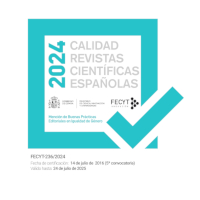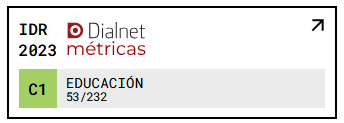A narrative review of computational thinking in Compulsory Secondary Education
DOI:
https://doi.org/10.18172/con.4644Keywords:
Abstract thinking, digital skill, Secondary Compulsory EducationAbstract
The objective of this work was to know the benefits that computational thinking brings to education and the proposals for its application in Secondary Education in the different Spanish regions and other European countries. For this, a narrative review of the scientific literature has been carried out, extracting articles in both languages Spanish and English from the following databases: Dialnet, Scopus, Google Scholar, Researchgate and Microsoft Academic. Among the main results found, in many countries the current trend is to introduce it into the curriculum, as well as a series of skills, characteristics and attitudes associated with it, including abstraction, problem decomposition, algorithmic thinking, automation, debugging and generalization. Among the main benefits that computational thinking brings is the improvement of digital competence, development and strengthening of socio-emotional skills, skills related to language and communication, and empowerment of collective work. As a conclusion, it is important to highlight that most of the European countries have implemented or are in the process of implementing more actions to strengthen the use of computational thinking among students.Downloads
References
Allan, W., Coulter, B., Denner, J., Erickson, J., Lee, I., Malyn-Smith, J. y Martin, F. (2010). Computational Thinking for Youth. ITEST Small Working Group on Computational Thinking.
Angeli, C., Voogt, J., Fluck, A., Webb, M., Cox, M., Malyn-Smith, J. y Zagami, J. (2016). A K-6 Computational Thinking Curriculum Framework- Implications for Teacher Knowledge. Educational Technology y Society, 19(3), 47-57.
Barr, D., Harrison, J., y Conery, L. (2011). Computational Thinking: A Digital Age Skill for Everyone. Learning y Leading with Technology, 38(6), 20-23.
Barr, V., y Stephenson, C. (2011). Bringing Computational Thinking to K-12: What is Involved and What is the Role of the Computer Science Education Community? ACM Inroads, 2(1), 48-54.
Basogain Olabe, X., Olabe Basogain, M. A. y Olabe Basogain, J. C. (2015). Pensamiento Computacional a través de la Programación: Paradigma de Aprendizaje. Revista De Educación a Distancia, 46(6). http://doi.org/10.6018/red/46/6
Bocconi, S., Chioccariello, A., Dettori, G., Ferrari, A. y Engelhardt, K. (2016). Developing computational thinking in compulsory education – Implications for policy and practice. Luxembourg: Publications Office of the European Union. Recuperado de https://ec.europa.eu/jrc/en/publication/eur-scientific-and-technical-research-reports/developing-computational-thinking-compulsory-education-implications-policy-and-practice
Caballero-González, Y. A. y García-Valcárcel, A. (2019). ¿Aprender con robótica en Educación Primaria? Un medio de estimular el pensamiento computacional. Education in the Knowledge Society, 20(1), 1-15. http://doi.org/10.14201/eks.21443
Código 21 (2015). Programar para aprender: orientaciones para el profesorado de Primaria. Pamplona: Gobierno de Navarra, Departamento de Educación. Recuperado de http://codigo21.educacion.navarra.es/profesorado/guia-programar-para-aprender-orientaciones-para-el-profesorado-de-primaria/
CSTA e ISTE (2011). Operational definition of Computational Thinking in K-12 education. Recuperado de https://id.iste.org/docs/ct-documents/computational-thinking-operational-definition-flyer.pdf?sfvrsn=2
Grover, S. (2018). The 5th ‘C’ of 21st Century Skills? Try Computational Thinking (Not Coding). Edsurge. Recuperado de https://www.edsurge.com/news/2018-02-25-the-5th-c-of-21st-century-skills-try-computational-thinking-not-coding.
Grover, S., y Pea, R. (2013). Computational Thinking in K-12 A Review of the State of the Field. Educational Researcher, 42(1), 38-43. https://doi.org/10.3102/0013189X12463051
Gurises Unidos (2017). Pensamiento computacional. Un aporte para la educación de hoy. Montevideo, Uruguay: Gurises Unidos. Recuperado de https://www.gurisesunidos.org.uy/wp-content/uploads/2017/11/PensamientoComputacional.pdf.
INTEF, Instituto Nacional de Tecnologías Educativas y de Formación del Profesorado (2018). Programación, robótica y pensamiento computacional en el aula. Situación en España. Madrid: Ministerio de Educación y Formación Profesional, INTEF. Recuperado de https://code.intef.es/wp-content/uploads/2018/10/Ponencia-sobre-Pensamiento-Computacional.-Informe-Final.pdf
INTEF, Instituto Nacional de Tecnologías Educativas y de Formación del Profesorado (2018). Situación de la competencia digital del alumnado en España – Comparativa de iniciativas. INTEF. Recuperado de https://intef.es/formacion-y-colaboracion/competencia-digital-educativa/
Lamprou, A. y Repenning, A. (2018). Computational Thinking ≠ Programming. SI Digital Magazine (SIDM). Recuperado de https://magazine.swissinformatics.org/en/computational-thinking-≠-programming/#_ftn1
Lee, I., Martin, F., Denner, J., Coulter, B., Allan, W., Erickson, J., Malyn-Smith, J. y Werner, L. (2011). Computational thinking for youth in practice. ACM Inroads, 2(1), 32-37. https://doi.org/10.1145/1929887.1929902
Posada, F. (2017). Pensamiento computacional en el aula. Póster presentado en Reunión Coordinadores TIC, Lanzarote, noviembre 2017.
Real Decreto 1105/2014, de 26 de diciembre, por el que se establece el currículo básico de la Educación Secundaria Obligatoria y del Bachillerato. Boletín Oficial del Estado, 3, de 3 de enero de 2015.
Roig-Vila, R. y Moreno-Isac, V. (2020). El pensamiento computacional en educación. Análisis bibliométrico y temático. RED. Revista de Educación a Distancia, 63(20), 1-24. http://doi.org/10.6018/red.402621
Román, M., Pérez, J. C. y Jiménez, C. (2015). Test de Pensamiento Computacional: diseño y psicometría general. En III Congreso Internacional sobre Aprendizaje, Innovación y Competitividad, Madrid, octubre 2015.
Sánchez Palacios, M. C. (2018). Enseñar Economía mediante el ABP: aprendizaje basado en problemas en Bachiller. Campus Educación Revista Digital Docente, 8, 47-50. Recuperado de https://www.campuseducacion.com/revista-digital-docente/numeros/8
Selby, C. C. y Woollard, J. (2013). Computational Thinking: The Developing Definition. University of Southampton (E-prints) 6 pp. Recuperado de https://eprints.soton.ac.uk/356481/
The Royal Society (2012). Shut down or restart? The way forward for computing in UK schools. Recuperado de https://royalsociety.org/~/media/education/computing-in-schools/2012-01-12-computing-in-schools.pdf
Weintrop, D., Beheshti, E., Horn, M., Orton, K., Jona, K., Trouille, L. y Wilensky, U. (2016). Defining Computational Thinking for Mathematics and Science Classrooms. Journal of Science Education and Technology, 25, 127-147. https://doi.org/10.1007/s10956-015-9581-5
Wing, J. M. (2006). Computational thinking. Communications of the ACM, 49(3), 33-35. https://doi.org/10.1145/1118178.1118215
Wing, J. M. (2008). Computational thinking and thinking about computing. Philosophical Transactions of the Royal Society of London A: Mathematical, Physical and Engineering Sciences, 366(1881), 3717-3725. https://doi.org/10.1098/rsta.2008.0118
Wing, J. M. (2011). Research Notebook: Computational Thinking-What and Why? The Link, The magazine of Carnegie Mellon University's School of Computer Science. Recuperado de https://www.cs.cmu.edu/link/research-notebook-computational-thinking-what-and-why
Woollard, J. (2016). CT Driving Computing Curriculum in England. CSTA Voice, 12(1), 4-5.
Zapata-Ross, M. (2015). Pensamiento computacional: Una nueva alfabetización digital. RED. Revista de Educación a Distancia, 46, 47 pp. Recuperado de https://revistas.um.es/red/article/view/240321
Downloads
Published
How to Cite
Issue
Section
License
The authors retain copyright of articles and authorize Contextos Educativos. Revista de Educación the first publication. They are free to share and redistribute the article without obtaining permission from the publisher as long as they give appropriate credit to the editor and the journal.
Self-archiving is allowed too. In fact, it is recommendable to deposit a PDF version of the paper in academic and/or institutional repositories.












